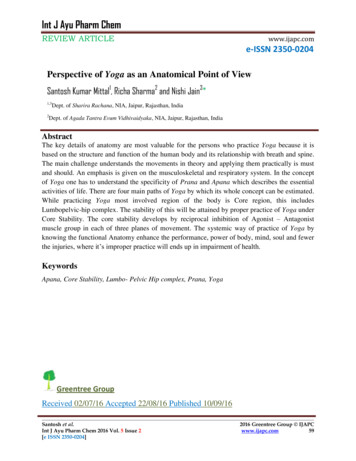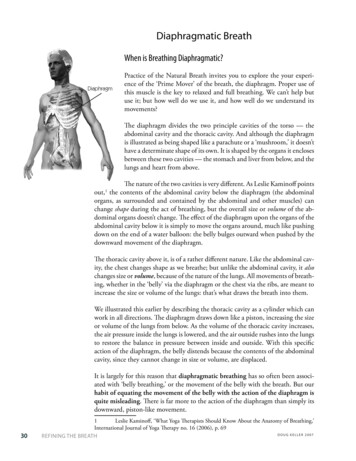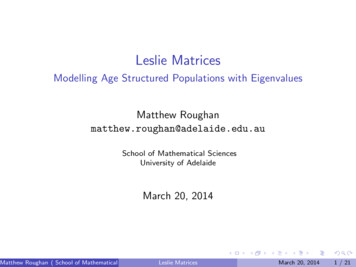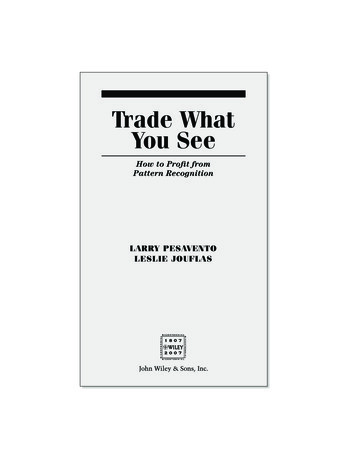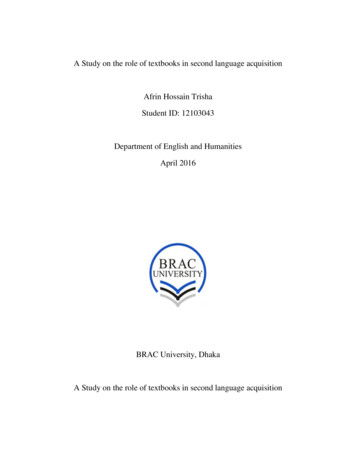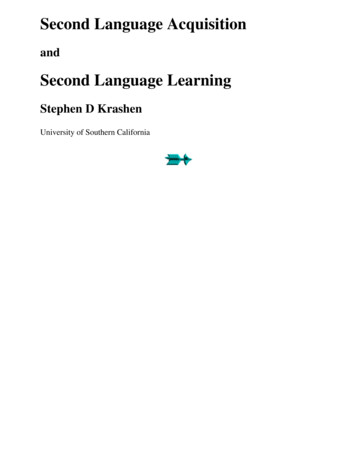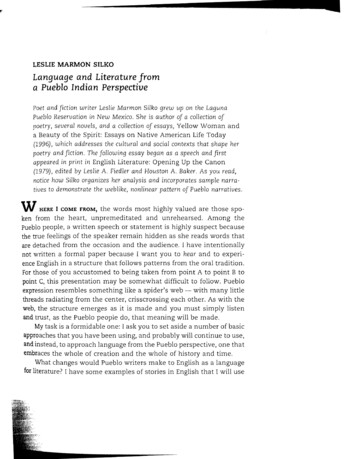
Transcription
l!'LESLIE MARMON SILKOLanguage and Literature froma Pueblo Indian PerspectivePoet and fiction writer Leslie Marmon Silko grew up on the LagunaPueblo Reservation in New Mexico. She is author of a collection ofpoetry, several novels, and a collection of essays, Yellow Woman anda Beauty of the Spirit: Essays on Native American Life Today(1996), which addresses the cultural and social contexts that shape herpoetry and fiction. The following essay began as a speech and firstappeared in print in English Literature: Opening Up the Canon(1979), edited by Leslie A. Fiedler and Houston A. Baker. As you read,notice how Silko organizes her analysis and incorporates sample narra tives to demonstrate the web like, nonlinear pattern of Pueblo narratives.WHERE I COME FROM, the words most highly valued are those spo ken from the heart, unpremeditated and unrehearsed. Among thePueblo people, a written speech or statement is highly suspect becausethe true feelings of the speaker remain hidden as she reads words thatare detached from the occasion and the audience. I have intentionallynot written a formal paper because I want you to hear and to experi ence English in a structure that follows patterns from the oral tradition.For those of you accustomed to being taken from point A to point B topoint C, this presentation may be somewhat difficult to follow. Puebloexpression resembles something like a spider's web - with many littlethreads radiating from the center, crisscrossing each other. As with theweb, the structure emerges as it is made and you must simply listenand trust, as the Pueblo people do, that meaning will be made.My task is a formidable one: I ask you to set aside a number of basicapproaches that you have been using, and probably will continue to use,and instead, to approach language from the Pueblo perspective, one thatembraces the whole of creation and the whole of history and time.What changes would Pueblo writers make to English as a languagefor literature? I have some examples of stories in English that I will use
. Chapter 59LITERARY ANALYSESto address this question. At the same time, I would like to explain theimportance of storytelling and how it relates to a Pueblo theory oflanguage.So I will begin, appropriately enough, with the Pueblo Creation story,an all-inclusive story of how life began. In this story, Tseitsinako, ThoughtWoman, by thinking of her sisters, and together with her sisters, thoughtof everything that is. In this way, the world was created. Everything inthis world was a part of the original creation; the people at home under stood that far away there were other human beings, also a part of thisworld. The Creation story even includes a prophecy, which describes theorigin of European and African peoples and also refers to Asians.This story, I think, suggests something about why the Pueblo peo ple are more concerned with story and communication and less con cerned with a particular language. There are at least six, possibly seven,distinct languages among the twenty pueblos of the southwesternUnited States, for example, Zuni and Hopi. And from mesa to mesa thereare subtle differences in language. But the particular language spokenisn't as important as what a speaker is trying to say, and this empha sis on the story itself stems, I believe, from a view of narrative particu lar to the Pueblo and other Native American peoples that is, thatlanguage is story.I will try to clarify this statement. At Laguna Pueblo, for example,many individual words have their own stories. So when one is telling astory, and one is using words to tell the story, each word that one isspeaking has a story of its own, too. Often the speakers or tellers willgo into these word-stories, creating an elaborate structure of stories within-stories. This structure, which becomes very apparent in theactual telling of a story, informs contemporary Pueblo writing andstorytelling as well as the traditional narratives. This perspective on nar rative - of story within story, the idea that one story is only the begin ning of many stories, and the sense that stories never truly end represents an important contribution of Native American cultures to theEnglish language.Many people think of storytelling as something that is done at bed time, that it is something done for small children. But when I use theII-roc:'".!:: 0o i.,roQJ ::l.r:.t::. V1'" c:QJ0\QJ'"'"'"QJv.a.0'"QJ'01.roQJ.,.V' .r:.rova.roro .QJ ro E §.V1QJ '"'tiro-a .-E 0\c: -' t.00.c-ac:ro.r:.
Silko / From a Pueblo Indian Perspectiveterm storytelling, I'm talking about something much bigger than that. I'mtalking about something that comes out of an experience and an under standing of that original view of creation - that we are all part of awhole; we do not differentiate or fragment stories and experiences. Inthe beginning, Tseitsinako, Thought Woman, thought of all things, andall of these things are held together as one holds many things togetherin a single thought.So in the telling (and you will hear a few of the dimensions of thistelling) first of all, as mentioned earlier, the storytelling always includesthe audience, the listeners. In fact, a great deal of the story is believedto be inside the listener; the storyteller's role is to draw the story out ofthe listeners. The storytelling continues from generation to generation.Basically, the origin story constructs our identity - within this story,we know who we are. We are the Lagunas. This is where we come from.We came this way. We came by this place. And so from the time we arevery young, we hear these stories, so that when we go out into the world,when one asks who we are, or where we are from, we immediatelyknow: we are the people who came from the north. We are the peopleof these stories.'In the Creation story, Antelope says that he will help knock a holein the earth so that the people can come up, out into the next world.Antelope tries and tries; he uses his hooves, but is unable to breakthrough. It is then that Badger says, "Let me help you." And Badger verypatiently uses his claws and digs a way through, bringing the peopleinto the world. When the Badger clan people think of themselves, orwhen the Antelope people think of themselves, it is as people who areof this story, and this is our place, and we fit into the very beginningwhen the people first came, before we began our journey south.Within the clans there are stories that identify the clan. One moves,then, from the idea of one's identity as a tribal person into clan iden tity, then to one's identity as a member of an extended family. And itis the notion of "extended family" that has produced a kind of story thatsome distinguish from other Pueblo stories, though Pueblo people donot. Anthropologists and ethnologists have, for a long time, differenti ated the types of stories the Pueblos tell. They tended to elevate the old,
-rChapter 59LITERARY ANALYSESsacred, and traditional stories and to brush aside family stories, the fam ily's account of itself. But in Pueblo culture, these family stories are givenequal recognition. There is no definite, present pattern for the way onewill hear the stories of one's own family, but it is a very critical part ofone's childhood, and the storytelling continues throughout one's life.One will hear stories of importance to the family -- sometimes won derful stories - stories about the time a maternal uncle got the biggestdeer that was ever seen and brought it back from the mountains. Andso an individual's identity will extend from the identity constructedaround the family"I am from the family of my uncle who brought inthis wonderful deer and it was a wonderful hunt."Family accounts include negative stories, too; perhaps an uncle didsomething unacceptable. It is very important that one keep track of allthese stories - both positive and not so positiveabout one's ownfamily and other families. Because even when there is no way aroundit - old Uncle Pete did do a terrible thing . by knowing the stories thatoriginate in other families, one is able to deal with terrible sorts of thingsthat might happen within one's own family. If a member of the familydoes something that cannot be excused, one always knows stories aboutsimilar inexcusable things done by a member of another family. But thisknowledge is not communicated for malicious reasons. It is very impor tant to understand this. Keeping track of all the stories within the com munity gives us all a certain distance, a useful perspective, that bringsincidents down to a level we can deal with. If others have done it before,it cannot be so terrible. If others have endured, so can we.The stories are always bringing us together, keeping this wholetogether, keeping this family together, keeping this clan together. "Don'tgo away, don't isolate yourself, but come here, because we have all hadthese kinds of experiences." And so there is this constant pullingtogether to resist the tendency to run or hide or separate oneself dur ing a traumatic emotional experience. This separation not only endan gers the group but the individual as well - one does not recover byoneself.Because storytelling lies at the heart of Pueblo culture, it is absurdto attempt to fix the stories in time. "When did they tell the stories?"III-VI. . §0 .,co Ii::!-E' VI Ii.C())CllVI())'"())VIuec.VI. CllCJ.,co.1:;;.r::couc. Illco .co Ii E/ijC.- CllVICll'V:;c:CJ Ii-0vE-oIII "'oo".0-0Cco.r::
Silko / From a Pueblo Indian Perspectiveft1Ior "What time of day does the storytelling take place?" .- these ques tions are nonsensical from a Pueblo perspective, because our storytellinggoes on constantly: as some old grandmother puts on the shoes of achild and tells her the story of a little girl who didn't wear her shoes,for instance, or someone comes into the house for coffee to talk with ateenage boy who has just been in a lot of trouble, to reassure him thatsomeone else's son has been in that kind of trouble, too. Storytelling isan ongoing process, working on many different levels.Here's one story that is often told at a time of individual crisis (andI want to remind you that we make no distinctions between types ofstory - historical, sacred, plain gossip - because these distinctions arenot useful when discussing the Pueblo experience of language). There wasa young man who, when he came back from the war in Vietnam, hadsaved up his army pay and bought a beautiful red Volkswagen. He wasvery proud of it. One night he drove up to a place called the King's Barright across the reservation line. The bar is notorious for many reasons,particularly for the deep arroyo* located behind it. The young man ranin to pick up a cold six-pack, but he forgot to put on his emergencybrake. And his little red Volkswagen rolled back into the arroyo and wasall smashed up. He felt very bad about it, but within a few days every body had come to him with stories about other people who had lost carsand family members to that arroyo, for instance, George Day's stationwagon, with his mother-in-law and kids inside. So everybody was say ing, "Well, at least your mother-in-law and kids weren't in the car whenit rolled in," and one can't argue with that kind of story. The story ofthe young man and his smashed-up Volkswagen was now joined withall the other stories of cars that fell into that arroyo.Now I want to tell you a very beautiful little story. It is a very oldstory that is sometimes told to people who suffer great family or per sonalloss. This story was told by my Aunt Susie. She is one of the firstgeneration of people at Laguna who began experimenting with English who began working to make English speak for us - that is, to speakfrom the heart. (1 come from a family intent on getting the stories told.)*Arroyo: ravine (Spanish). [Editor's note]
Chapter 59LITERARY ANALYSESAs you read the story, I think you will hear that. And here and there, Ithink, you will also hear the influence of the Indian school* at Carlisle,Pennsylvania, where my Aunt Susie was sent (like being sent to prison)for six years.This scene is set partly in Acoma, partly in Laguna. Waithea was alittle girl living in Acoma and one day she said, "Mother, I would like tohave some yashtoah to eat." Yashtoah is the hardened crust of corn mushthat curls up. Yashtoah literally means "curled up." She said, "I wouldlike to have some yashtoah," and her mother said, "My dear little girl, Ican't make you any yashtoah because we haven't any wood, but if youwill go down off the mesa, down below, and pick up some piecesof wood and bring them home, I will make you some yashtoah." SoWaithea was glad and ran down the precipitous cliff of Acoma mesa.Down below, just as her mother had told her, there were pieces of wood,some curled, some crooked in shape, that she was to pick up and takehome. She found just such wood as these.She brought them home in a little wicker basket. First she called toher mother as she got home, "Nayah, deeni! Mother, upstairs!" The Pueblopeople always called "upstairs" because long ago their homes were two,three stories, and they entered from the top. She said, "Deeni! UPSTAIRS!"and her mother came. The little girl said, "I have brought the wood youwanted me to bring." And she opened her little wicker basket to layoutthe pieces of wood but here they were snakes. They were snakes insteadof crooked sticks of wood. And her mother said, "Oh my dear child, youhave brought snakes instead!" She said, "Go take them back and putthem back just where you got them." And the little girl ran down themesa again, down below to the flats. Andput those snakes backjust where she got them. They were snakes instead and she wasvery hurt about this and so she said, ''I'm not going home. I'm going toKawaik, the beautiful lake place, Kawaik, and drown myself in the lake,byn'yah'nah [the "west lake"]. I will go there and drown myself."*Indian school: the Carlisle Indian Industrial School, federally supported boardingschool attended by more than 15,000 Native American children from 1879 to 1918. [Edi tor's note] -roc'"· .20"".,toQJ::l.e :t:.'"'" lJ.C lJ0'\'" lJ'"'" lJv0C.'" lJ0'\.,QJ., '".erova. toto . lJtO"' E "0 ,- lJ'"E '"0'\C.:,000'6.0 cto.eto"0
Silko I From a Pueblo Indian PerspectiveSo she started off, and as she passed the Enchanted Mesa nearAcoma she met an old man, very aged, and he saw her running, and hesaid, "My dear child, where are you going?" ''I'm going to Kawaik andjump into the lake there." "Why?" "Well, because," she said, "my motherdidn't want to make any yashtoah for me." The old man said, "Oh, no!You must not go my child. Come with me and I will take you home," Hetried to catch her, but she was very light and skipped along. And everytime he would try to grab her she would skip faster away from him.The old man was coming home with some wood strapped to hisback and tied with yucca. He just let the strap go and let the wood drop.He went as fast as he could up the cliff to the little girl's home. Whenhe got to the place where she lived, he called to her mother. "Deeni!""Come on up!" And he said, "I can't. I just came to bring you a message.Your little daughter is running away. She is going to Kawaik to drownherself in the lake there." HOh my dear little girl!" the mother said. Soshe busied herself with making the yashtoah her little girl liked so much.Corn mush curled at the top. (She must have found enough wood to boilthe corn meal and make the yashtoah.)While the mush was cooking off, she got the little girl's clothing, hermanta dress'" and buckskin moccasins and all her other garments, and putthem in a bundle - probably a yucca bag. And she started down as fasta she could on the east side of Acoma. (There used to be a trail there, youknow. It's gone now, but it was accessible in those days.) She saw herdaughter way at a distance and she kept calling: "Stsamaku! My daugh ter! Come back! I've got your yashtoah for you." But the little girl wouldnot turn. She kept on ahead and she cried: "My mother, my mother, shedidn't want me to have any yashtoah. So now I'm going to Kawaik anddrown myself." Her mother heard her cry and said, "My little daughter,come back here!" "No," and she kept a distance away from her. And theycame nearer and nearer to the lake. And she could see her daughter now,very plain. "Come back, my daughter! I have your yashtoah." But no, shekept on, and finally she reached the lake and she stood on the edge.*Manta: square, blanketlike cloth used as a cloak. [Editor's note]
,"""., Chapter 59LITERARY ANALYSESShe had tied a little feather in her hair, which is traditional (in deaththey tie this feather on the head). She carried a feather, the little girldid, and she tied it in her hair with a piece of string, right on top of herhead she put the feather. Just as her mother was about to reach her,she jumped into the lake. The little feather was whirling around andaround in the depths below. Of course the mother was very sad. Shewent, grieved, back to Acoma and climbed her mesa home. She stoodon the edge of the mesa and scattered her daughter's clothing, the lit tle moccasins, the yashtoah. She scattered them to the east, to the west,to the north, to the south. And the pieces of clothing and the mocca sions and yashtoah, all turned into butterflies. And today they say thatAcoma has more beautiful butterflies: red ones, white ones, blue ones ,yellow ones. They came from this little girl's clothing.Now this is a story anthropologists would consider very old. The ver sion I have given you is just as Aunt Susie tells it. You can occasionallyhear some English she picked up at Carlislewords like "precipitous."You will also notice that there is a great deal of repetition, and a littlereminder about yashtoah, and how it is made. There is a remark aboutthe cliff trail at Acoma - that it was once there, but is there no longer.This story may be told at a time of sadness or loss, but within this storymany other elements are brought together. Things are not separated outand categorized; all things are brought together. So that the reminderabout the yashtoah is valuable information that is repeated - a recipe,if you will. The information about the old trail at Acoma reveals that sto ries are, in a sense, maps, since even to this day there is little informa tion or material about trails that is passed around with writing. In thestructure of this story the repetitions are, of course, designed to help youremember. It is repeated again and again, and then it moves on.The next story I would like to tell is by Simon Ortiz, from AcomaPueblo. He is a wonderful poet who also works in narrative. One of thethings I find very interesting in this short story is that if you listen veryclosely, you begin to hear what I was talking about in terms of a storynever beginning at the beginning, and certainly never ending. As theHopis sometimes say, "Well, it has gone this far for a while." There isalways that implication of a continuing. The other thing I want you toII!-ttl '"C· .20 .,'llQ) .c:.'!:::. V '" '"Q)'"vcO'lVIQ)Q)'"Q)O'l0a.Q) '., V' .c.'llv 00. ttlQ)ttl E -0 .Q)V E 0,c-0 0Q).;,L00.0-0ctV.s::.
Silko I From a Pueblo Indian Perspectivelisten for is the many stories within one story. Listen to the kinds of sto ries contained within the main story - stories that give one a familyidentity and an individual identity, for example. This story is called"Home Country":"Well, it's been a while. I think in 1947 was when I left. My hus band had been killed in Okinawa* some years before. And so I hadno more husband. And I had to make a living. 0 I guess I could havelooked for another man but I didn't want to. It looked like the warhad made some of them into a bad way anyway. I saw some ofthem come home like that. They either got drunk or just stayedaround a while or couldn't seem to be satisfied anymore with whatwas there. I guess now that I think about it, that happened to mealthough I wasn't in the war not in the Army or even much off thereservation just that several years at the Indian School. Well therewas that feeling things were changing not only the men the boys,but things were changing."One day the home nurse the nurse that came from the Indianhealth service was at my mother's home my mother was getting nearthe end real sick and she said that she had been meaning to ask mea question. I said what is the question. And the home nurse said wellyour mother is getting real sick and after she is no longer around foryou to take care of, what will you be doing you and her are the onlyones here. And I said I don't know. But I was thinking about it whatshe said made me think about it. And then the next time she cameshe said to me Eloise the government is hiring Indians now in theIndian schools to take care of the boys and girls I heard one of thesupervisors saying that Indians are hard workers but you have tosupervise them a lot and I thought of you well because you've beentaking care of your mother real good and you follow all my instruc tions. She said I thought of you because you're a good Indian girl andyou would be the kind of person for that job. I didn't say anything Ihad not ever really thought about a job but I kept thinking about it."Well my mother she died and we buried her up at the oldplace the cemetery there it's real nice on the east side of the hill*Okinawa: southernmost Japanese island, site of fierce fighting between Japaneseand American forces in World War II. [Editor's note]
-.,Chapter 59LITERARY ANALYSESwhere the sun shines warm and the wind doesn't blow too muchsand around right there. Well I was sad we were all sad for a whilebut you know how things are. One of my aunties came over andshe advised me and warned me about being too sorry about it andall that she wished me that I would not worry too much about itbecause old folks they go along pretty soon life is that way and thenshe said that maybe I ought toin one of my aunties kids ortwo because there was a lot of them kids and I was all by myselfnow. But I was so young and I thought that I might do that youknow take care of someone but I hadthinking too of what thehome nurse said to me about working. Hardly anybody at our homewas working at something like that no woman anyway. And I wouldhave to move away."Well I did just that. I remember that day very well. I told myaunties and they were all crying and we all went up to the old high way where the bus to town passes by every day. I was wearing anold kind of bluish sweater that was kind of big that one of mycousins who was older had got from a white person a tourist onesummer in trade for something she had made a real pretty basket.She gave me that and I used to have a picture of me with it on it'skind of real ugly. Yeah that was the day I left wearing a baggysweater and carrying a suitcase that someone gave me too I thinkor maybe it was the home nurse there wasn't much in it anywayeither. I was scared and everybody seemed to be sad I was so youngand skinny then. My aunties said one of them who was real fat youmake sure you eat now make your own tortillas drink the milk andstuff like candies is no good she learned that from the nurse. Makesure you got your letter my auntie said. I had it folded into mypurse. Yes I have one too a brown one that my husband when hewas still alive one time on furlough he brought it on my birthdayit was a nice purse and still looked new because I never used it."The letter said that I had a job at Keams Canyon the board ing school there but I would have to go to the Agency first for somepapers to be filled and that's where I was going first. The Agency.And then they would send me out to Keams Canyon. I didn't evenknow where it was except that someone of our relatives said thatit was near Hopi. My uncles teased me about watching out for theHopi men and boys don't let them get too close they said well you-Cll '"C. 0.o ' ,fOCli :J.c.-t . '"'" cClien'"Cli. .cCllvCli 'CliCll0. V1V1Clioen va.ro. Cll E--c. en"0 'ViCliCliE-oIIIen.S-01'0Cli.-'"oo.0-0cro.c
,Silko I From a Pueblo Indian Perspectiveknow how they are and they were pretty strict too about thosethings and then they were joking and then they were not too andso I said aw they won't get near to me I'm too ugly and I promisedI would be careful anyway."So we all gathered for a while at my last auntie's house andthen the old man my grandfather brought his wagon and horses tothe door and we all got in and sat there for a while until my auntietold her father okay father let's go and shook his elbow because thepoor old man was old by then and kind of going to sleep all the timeyou had to talk to him real loud. I had about ten dollars I think thatwas a lot of money more than it is now you know and when we gotto the highway where the Indian road which is just a dirt road goesoff the pave road my grandfather reached into his blue jeans andpulled out a silver dollar and put it into my hand. I was so shocked.We were all so shocked. We all looked around at each other we did n't know where the old man had gotten it because we were real poortwo of my uncles had to borrow on their accounts at the trading storefor the money I had in my purse but there it was a silver dollar sobig and shrinking in my grandfather's hand and then in my hand."Well I was so shocked and everybody was so shocked that weall started crying right there at the junction of that Indian road andthe pave highway I wanted to be a little girl again running after theold man when he hurried with his long legs to the cornfields orwent for water down to the river. He was old then and his eye wasturned gray and he didn't do much anymore except drive the wagonand chop a little bit of wood but I just held him and I just held himso tightly."Later on I don't know what happened to the silver dollar ithad a date of 1907 on it but I kept it for a long time because I guessI wanted to have it to remember when I left my home country.What I did in between then and now is another story but that's thetime I moved away,"is what she said. 1There are a great many parallels between Pueblo experiences andthose of African and Caribbean peoples - one is that we have all hadthe conqueror's language imposed on us. But our experience with Eng lish has been somewhat different in that the Bureau of indian Affairs
Chapter 59LITERARY ANALYSESschools were not interested in teaching us the canon of Western clas sics. For instance, we never heard of Shakespeare. We were given Dickand ]ane,* and I can remember reading that the robins were headingsouth for the winter. It took me a long time to figure out what was goingon. I worried for quite a while about our robins in Laguna because theydidn't leave in the winter, until I finally realized that all the big text book companies are up in Boston and their robins do go south in thewinter. But in a way, this dreadful formal education freed us by encour aging us to maintain our narratives. Whatever literature we wereexposed to at school (which was damn little), at home the storytelling,the special regard for telling and bringing together through the telling,was going on constantly.And as the old people say, "If you can remember the stories, youwill be all right. Just remember the stories." When I returned to LagunaPueblo after attending college, I wondered how the storytelling was con tinuing (anthropologists say that Laguna Pueblo is one of the more accul turated pueblos), so I visited an English class at Laguna Acoma HighSchool. I knew the students had cassette tape recorders in their lockersand stereos at home, and that they listened to Kiss and Led Zeppelinand were all informed about popular culture in general. I had with mean anthology of short stories by Native American writers, The Man toSend Rain Clouds. One story in the book is about the killing of a statepoliceman in New Mexico by three Acoma Pueblo men in the early1950s. 2 I asked the students how many had heard this story and steeledmyself for the possibility that the anthropologists were right, that theold traditions were indeed dying out and the students would be igno rant of the story. But instead, all but one or two raised their hands they had heard the story, just as I had heard it when I was young, somein English, some in Laguna.One of the other advantages that we Pueblos have enjoyed is thatwe have always been able to stay with the land. Our stories cannot beseparated from their geographical locations, from actual physical places*Dick and Jane: characters in an early-reading series common in American schoolsfrom the 1930s through the 1960s. [Editor's note)iii-II'II'. :. -0C. '0 l)::J0'1 '0 C0 .c.t:.'" C,lVIC,lV '"Ulu00.VIC,l0'1Ul. .II'.c 'Ouo. '0 '0-.w 'O E §,V 0W""c:"0.0"0 .-E 0'1 '0(l).0, 0"0c: '0.c
Silko / From a Pueblo Indian Perspectiveon the land. We were not relocated like so many Native American groupswho were torn away from their ancestral land. And our stories are somuch a part of these places that it is almost impossible for future gen erations to lose them -- there is a story connected with every place,every object in the landscape.Dennis Brutus has talked about the "yet unborn" as well as "thosefrom the past," and how we are still all in this place, and languagethestorytelling is our way of passing through or being with them, or beingtogether again. When Aunt Susie told her stories, she would tell a youngerchild to go open the door so that our esteemed predecessors might bringin their gifts to us. "They are out there," Aunt Susie would say. "Let themcome in. They're here, they're here with us within the stories."A few years ago, when Aunt Susie was 106, I paid her a visit, andwhile I was there she said, "Well, I'll be leaving here soon. I think I'll beleaving here next week, and I will be go
will hear the stories of one's own family, but it is a very critical part of one's childhood, and the storytelling continues throughout one's life. One will hear stories of importance to the family --sometimes won derful stories - stories about the time a maternal uncle got the biggest


